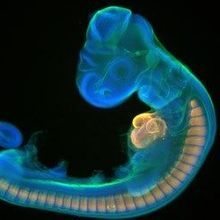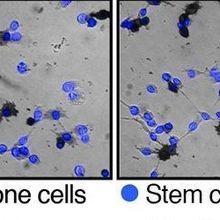Login
Subscribedevelopmental biology

Image of the Day: New Neurons
The Scientist and The Scientist Staff | Mar 28, 2018 | 1 min read
Scientists discover a molecular factor that allows them to follow neurons from birth to maturity.

Tadpoles Keep Eating Because They Don’t Feel Full
Catherine Offord | Mar 27, 2018 | 1 min read
Baby frogs don’t develop the neural circuitry responsible for feeding inhibition until they begin metamorphosing into adults.

Image of the Day: Morphing Cells
The Scientist and The Scientist Staff | Mar 27, 2018 | 1 min read
By removing a single gene, researchers change the developmental fate of tumor cells in mice.

Eat Yourself to Live: Autophagy’s Role in Health and Disease
Vikramjit Lahiri and Daniel J. Klionsky | Mar 1, 2018 | 10+ min read
New details of the molecular process by which our cells consume themselves point to therapeutic potential.

Are the Brains of Transgender People Different from Those of Cisgender People?
Shawna Williams | Mar 1, 2018 | 10+ min read
Research into the biological basis of gender identity is in its infancy, but clues are beginning to emerge.

Primitive Human Eggs Grown to Full Maturity in the Lab
Ashley Yeager | Feb 9, 2018 | 2 min read
The technique could combat infertility, but it's still not clear whether these eggs are normal and functional.

Infographic: Skotomorphogenesis Versus Photomorphogenesis
Kerry Grens | Jan 31, 2018 | 1 min read
Pectin fragments may signal plant cells to maintain a type of growth suited to darkness.

Image of the Day: See You Later!
The Scientist and The Scientist Staff | Jan 8, 2018 | 1 min read
Developmental biologists take a close look at how alligator embryos grow.

Thousands of Mutations Accumulate in the Human Brain Over a Lifetime
Ruth Williams | Dec 7, 2017 | 4 min read
Single-cell genome analyses reveal the amount of mutations a human brain cell will collect from its fetal beginnings until death.

Captivated by Chromosomes
Anna Azvolinsky | Dec 1, 2017 | 8 min read
Peering through a microscope since age 14, Joseph Gall, now 89, still sees wonder at the other end.

Passing the Torch
Mary Beth Aberlin | Dec 1, 2017 | 3 min read
Looking back, looking forward

New Techniques Detail Embryos’ First Hours and Days
Jef Akst | Dec 1, 2017 | 10+ min read
New technologies reveal the dynamic changes in mouse and human embryos during the first week after fertilization.

Infographic: How Embryos Take Control of Their Own Development
Jef Akst | Nov 30, 2017 | 3 min read
The switch from maternal factors involves dynamic reprogramming of the zygotic genome.

Image of the Day: Skate Youngsters
The Scientist and The Scientist Staff | Nov 28, 2017 | 1 min read
Scientists study the development of scales in skate embryos.

Image of the Day: Tadpole Prism
The Scientist and The Scientist Staff | Nov 3, 2017 | 1 min read
Scientists are making use of Xenopus tadpoles to study autism risk genes.

Image of the Day: Fragile Brain
The Scientist and The Scientist Staff | Oct 3, 2017 | 1 min read
In Fragile X syndrome—a genetic mishap that results in cognitive delays—the lack of a translation-repressing protein leads to the rampant accumulation of other proteins in the mouse brain.

Macrophages Are the Ultimate Multitaskers
Claire Asher | Oct 1, 2017 | 10+ min read
From guiding branching neurons in the developing brain to maintaining a healthy heartbeat, there seems to be no job that the immune cells can’t tackle.

Infographic: Macrophages Around the Body
Claire Asher | Sep 30, 2017 | 2 min read
In addition to circulating in the blood as immune sentinels, macrophages play specialized roles in different organs around the body.

Water Level in a Cell Can Determine Its Fate
Kerry Grens | Sep 27, 2017 | 2 min read
Adding or removing water changes how stem cells differentiate.

CRISPR Used in Human Embryos to Probe Gene Function
Ashley P. Taylor | Sep 20, 2017 | 2 min read
OCT4 is necessary for blastocyst formation in the human embryo, researchers report.